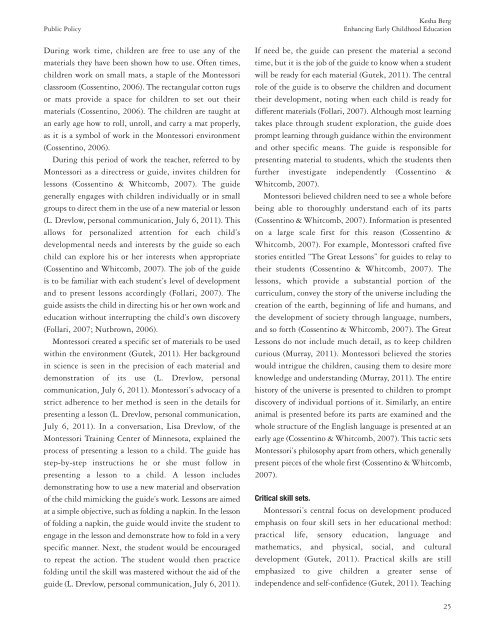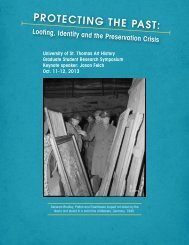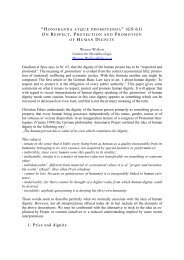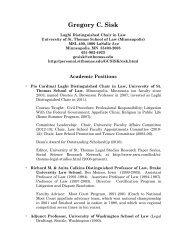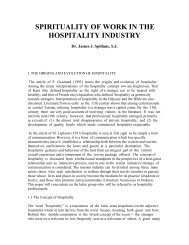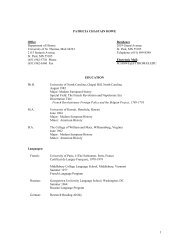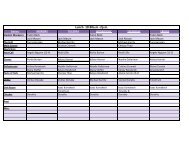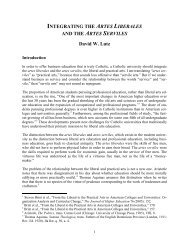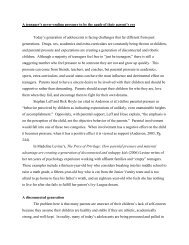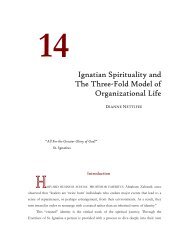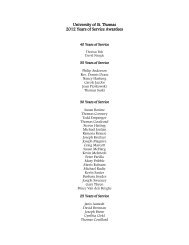dr. ronald e. mcnair acknowledgements - University of St. Thomas
dr. ronald e. mcnair acknowledgements - University of St. Thomas
dr. ronald e. mcnair acknowledgements - University of St. Thomas
You also want an ePaper? Increase the reach of your titles
YUMPU automatically turns print PDFs into web optimized ePapers that Google loves.
Kesha Berg<br />
Public Policy Enhancing Early Childhood Education<br />
During work time, chil<strong>dr</strong>en are free to use any <strong>of</strong> the<br />
materials they have been shown how to use. Often times,<br />
chil<strong>dr</strong>en work on small mats, a staple <strong>of</strong> the Montessori<br />
classroom (Cossentino, 2006). The rectangular cotton rugs<br />
or mats provide a space for chil<strong>dr</strong>en to set out their<br />
materials (Cossentino, 2006). The chil<strong>dr</strong>en are taught at<br />
an early age how to roll, unroll, and carry a mat properly,<br />
as it is a symbol <strong>of</strong> work in the Montessori environment<br />
(Cossentino, 2006).<br />
During this period <strong>of</strong> work the teacher, referred to by<br />
Montessori as a directress or guide, invites chil<strong>dr</strong>en for<br />
lessons (Cossentino & Whitcomb, 2007). The guide<br />
generally engages with chil<strong>dr</strong>en individually or in small<br />
groups to direct them in the use <strong>of</strong> a new material or lesson<br />
(L. Drevlow, personal communication, July 6, 2011). This<br />
allows for personalized attention for each child’s<br />
developmental needs and interests by the guide so each<br />
child can explore his or her interests when appropriate<br />
(Cossentino and Whitcomb, 2007). The job <strong>of</strong> the guide<br />
is to be familiar with each student’s level <strong>of</strong> development<br />
and to present lessons accordingly (Follari, 2007). The<br />
guide assists the child in directing his or her own work and<br />
education without interrupting the child’s own discovery<br />
(Follari, 2007; Nutbrown, 2006).<br />
Montessori created a specific set <strong>of</strong> materials to be used<br />
within the environment (Gutek, 2011). Her background<br />
in science is seen in the precision <strong>of</strong> each material and<br />
demonstration <strong>of</strong> its use (L. Drevlow, personal<br />
communication, July 6, 2011). Montessori’s advocacy <strong>of</strong> a<br />
strict adherence to her method is seen in the details for<br />
presenting a lesson (L. Drevlow, personal communication,<br />
July 6, 2011). In a conversation, Lisa Drevlow, <strong>of</strong> the<br />
Montessori Training Center <strong>of</strong> Minnesota, explained the<br />
process <strong>of</strong> presenting a lesson to a child. The guide has<br />
step-by-step instructions he or she must follow in<br />
presenting a lesson to a child. A lesson includes<br />
demonstrating how to use a new material and observation<br />
<strong>of</strong> the child mimicking the guide’s work. Lessons are aimed<br />
at a simple objective, such as folding a napkin. In the lesson<br />
<strong>of</strong> folding a napkin, the guide would invite the student to<br />
engage in the lesson and demonstrate how to fold in a very<br />
specific manner. Next, the student would be encouraged<br />
to repeat the action. The student would then practice<br />
folding until the skill was mastered without the aid <strong>of</strong> the<br />
guide (L. Drevlow, personal communication, July 6, 2011).<br />
If need be, the guide can present the material a second<br />
time, but it is the job <strong>of</strong> the guide to know when a student<br />
will be ready for each material (Gutek, 2011). The central<br />
role <strong>of</strong> the guide is to observe the chil<strong>dr</strong>en and document<br />
their development, noting when each child is ready for<br />
different materials (Follari, 2007). Although most learning<br />
takes place through student exploration, the guide does<br />
prompt learning through guidance within the environment<br />
and other specific means. The guide is responsible for<br />
presenting material to students, which the students then<br />
further investigate independently (Cossentino &<br />
Whitcomb, 2007).<br />
Montessori believed chil<strong>dr</strong>en need to see a whole before<br />
being able to thoroughly understand each <strong>of</strong> its parts<br />
(Cossentino & Whitcomb, 2007). Information is presented<br />
on a large scale first for this reason (Cossentino &<br />
Whitcomb, 2007). For example, Montessori crafted five<br />
stories entitled “The Great Lessons” for guides to relay to<br />
their students (Cossentino & Whitcomb, 2007). The<br />
lessons, which provide a substantial portion <strong>of</strong> the<br />
curriculum, convey the story <strong>of</strong> the universe including the<br />
creation <strong>of</strong> the earth, beginning <strong>of</strong> life and humans, and<br />
the development <strong>of</strong> society through language, numbers,<br />
and so forth (Cossentino & Whitcomb, 2007). The Great<br />
Lessons do not include much detail, as to keep chil<strong>dr</strong>en<br />
curious (Murray, 2011). Montessori believed the stories<br />
would intrigue the chil<strong>dr</strong>en, causing them to desire more<br />
knowledge and understanding (Murray, 2011). The entire<br />
history <strong>of</strong> the universe is presented to chil<strong>dr</strong>en to prompt<br />
discovery <strong>of</strong> individual portions <strong>of</strong> it. Similarly, an entire<br />
animal is presented before its parts are examined and the<br />
whole structure <strong>of</strong> the English language is presented at an<br />
early age (Cossentino & Whitcomb, 2007). This tactic sets<br />
Montessori’s philosophy apart from others, which generally<br />
present pieces <strong>of</strong> the whole first (Cossentino & Whitcomb,<br />
2007).<br />
Critical skill sets.<br />
Montessori’s central focus on development produced<br />
emphasis on four skill sets in her educational method:<br />
practical life, sensory education, language and<br />
mathematics, and physical, social, and cultural<br />
development (Gutek, 2011). Practical skills are still<br />
emphasized to give chil<strong>dr</strong>en a greater sense <strong>of</strong><br />
independence and self-confidence (Gutek, 2011). Teaching<br />
25


